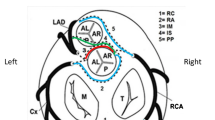Abstract
Background
Anomalous origin of the coronary artery from the contralateral coronary sinus is a rare coronary anomaly associated with sudden death. The inter-arterial course is most closely associated with sudden death, but it has been suggested that the presence of an intramural segment of a right anomalous coronary is associated with more symptoms and therefore may be an important criterion for intervention in these patients.
Objective
To demonstrate that MR angiography can accurately determine the presence or absence of an intramural segment in an anomalous coronary artery.
Materials and methods
All studies of children who underwent MR angiography for the evaluation of an anomalous coronary artery were retrospectively reviewed by two pediatric radiologists in consensus. Criteria for an intramural anomalous coronary artery were the presence of a small or slit-like ostium and the relative smaller size of the proximal intramural portion of the coronary artery in relation to the more distal epicardial coronary artery. The anomalous coronary artery was classified as not intramural if these two findings were absent. These findings were correlated with operative reports confirming the presence or absence of an intramural segment.
Results
Twelve patients (86%) met MR angiography criteria for the presence of an intramural course. Only 2 patients (14%) met MR angiography criteria for a non-intramural course. When correlating with intraoperative findings, MR angiography was successful in distinguishing between intramural and non-intramural anomalous coronary arteries in all cases (P = 0.01).
Conclusion
MR angiography may be able to reliably identify the intramural segment of an anomalous coronary artery in older children using the imaging criteria of a small or slit-like ostium and relative decrease in size of the proximal portion of the anomalous coronary artery compared to the distal portion of the anomalous coronary artery. Determining the presence of the intramural segment may help with surgical planning and may be an important criterion for the determination of intervention in patients with inter-arterial anomalous right coronary arteries.






Similar content being viewed by others
References
Fujimoto S, Kondo T, Orihara T et al (2011) Prevalence of anomalous origin of coronary artery detected by multi-detector computed tomography at one center. J Cardiol 57:69–76
Frescura C, Basso C, Thiene G et al (1998) Anomalous origin of coronary arteries and risk of sudden death: a study based on an autopsy population of congenital heart disease. Hum Pathol 29:689–695
Maron B (2003) Sudden death in young athletes. N Eng J Med 349:1064–1075
Shinbane JS, Shriki J, Fleischman F et al (2013) Anomalous coronary arteries: cardiovascular computed tomographic angiography for surgical decisions and planning. World J Pediatr Congenit Heart Surg 4:1421–1454
Shriki JE, Shinbane JS, Rashid MA et al (2012) Identifying, characterizing, and classifying congenital anomalies of the coronary arteries. Radiographics 32:453–468
Angelini P (2007) Coronary artery anomalies: an entity in search of an identity. Circulation 115:1296–1305
Mainwaring RD, Reddy VM, Reinhartz O et al (2014) Surgical repair of anomalous aortic origin of a coronary artery. Eur J Cardiothorac Surg 46:20–26
Gulati R, Reddy VM, Culbertson C et al (2007) Surgical management of coronary artery arising from the wrong sinus, using standard and novel approaches. J Thorac Cardiovasc Surg 134:1171–1178
Mainwaring RD, Reddy VM, Reinhartz O et al (2011) Anomalous aortic origin of a coronary artery: surgical results and medium-term follow-up in 50 patients. Ann Thorac Surg 92:691–697
Kaushal S, Becker CL, Popescu AR et al (2011) Intramural coronary length correlates with symptoms in patients with anomalous aortic origin of the coronary artery. Ann Thorac Surg 92:986–992
Miller JA, Anavekar NS, el Yamen MM et al (2012) Computed tomographic angiography identification of intramural segments in anomalous coronary arteries with interarterial course. Int J Cardiovasc Imaging 28:1525–1532
Sheahan D, Vasanawala S, Newman B et al. (2011) Diagnostic accuracy of coronary CTA determining intramural course of malignant aberrant coronary artery [abstract]. In: Radiological Society of North America 2011 Scientific Assembly and Annual Meeting, 26 Nov – 2 Dec 2011, Chicago, IL
Kim WY, Danias PG, Flamm SD et al (2001) Coronary magnetic resonance angiography for the detection of coronary stenosis. N Eng J Med 345:1863–1869
Tangchareon T, Bell A, Hegde S et al (2011) Detection of coronary artery anomalies in infants and young children with congenital heart disease by using MR imaging. Radiology 259:240–247
Liu X, Bi Z, Huang J et al (2008) Contrast-enhanced whole-heart coronary magnetic resonance angiography at 3.0 T. Invest Radiol 43:663–668
Gweon HM, Kim SJ, Lee SM et al (2011) 3D whole-heart coronary MR angiography at 1.5T in healthy volunteers: comparison between unenhanced SSFP and Gd-enhanced FLASH sequences. Korean J Radiol 12:679–685
Goo HW, Suh DS (2006) Tube current reduction in pediatric non-ECG-gated heart CT by combined tube current modulation. Pediatr Radiol 36:344–351
Sakuma H (2011) Coronary CT versus MR angiography: the role of MR angiography. Radiology 258:340–349
Keegan J (2014) Coronary artery wall imaging. J Magn Reson Imaging. doi:10.1002/jmri.24766
Conflicts of interest
Mr. David M. Hitt is an employee of Philips Healthcare. Dr. Taylor Chung discloses receiving an academic speaker’s honorarium from Philips Healthcare.
Author information
Authors and Affiliations
Corresponding author
Rights and permissions
About this article
Cite this article
Biko, D.M., Chung, C., Hitt, D.M. et al. High-resolution coronary MR angiography for evaluation of patients with anomalous coronary arteries: visualization of the intramural segment. Pediatr Radiol 45, 1146–1152 (2015). https://doi.org/10.1007/s00247-015-3302-3
Received:
Revised:
Accepted:
Published:
Issue Date:
DOI: https://doi.org/10.1007/s00247-015-3302-3




